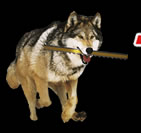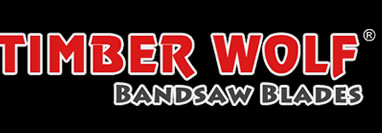 |
 |
 |
 |
Timber Wolf® Silicon steel blades are very stable at low tension or lower tension than what is normally recommended by most saw manufacturers and other blade manufacturers. By using less tension you will prolong blade life, consume approximately 20% less horsepower and increase the life of your wheel shafts and bearings. If a specific cutting application requires that more tension be applied to the blade, such as when resawing large material or cutting green logs, the recommended force for these blades can be increased by as much as 20%.
To apply the exact same blade tension each time saws would require a very expensive hydraulic or air strain tensioning system to create a repeatable tensioning method. These systems would make saws cost prohibitive for most consumers as are the high quality tension gauges such as the Lenox® and Starrett® brands which can also give us a repeatable method for applying tension.
The so called “deflection” method for tensioning, measuring the lateral defection of a blade, is more Kentucky windage than anything. In order to use deflection as a measure of applied force we would have to calibrate every steel type, blade width and blade thickness for every size saw and then create a tool to precisely measure the lateral deflection of the blade which is not practical.
If you happen to own a high quality tension/strain gauge, below is a list of recommended psi for each width of Timber Wolf Silicon steel blade. If you do not own a tension gauge please see the “Flutter Test” method below this list:
|
Width Minimum/Maximum tension
1/8" = 7,000/10,000 psi
3/16" = 7,500/10,500
1/4" = 8,000/11,000
3/8" = 9,000/12,000
3/8" x .032 = 11,000/14,000
1/2" = 10,000/13,000
1/2" x .032 = 12,000/15,000
3/4" x .025 = 11,000/14,000
3/4" = 13,000/16,000
1" = 14,000/17,000
|
THE “FLUTTER TEST” FOR PROPER SILICON STEEL BLADE TENSIONING
|
This tensioning method is a guideline and should be used whenever possible. By using less tension you will prolong blade life, consume approximately 20% less horsepower and increase the life of your wheel shafts and bearings. If a specific cutting application requires that more tension be applied to the blade, such as resawing large material or cutting extremely large diameter logs, the determined force can be increased by as much as 20%.
|
|
A. BAND SAWS WITH TURN-SCREW SPRING TENSIONERS:
Note: You will not be cutting any wood during this test. Also, your band saw tires and wheels must be in good working order. This test will not provide you with useful results if performed on a saw with damaged, cracked or flattened band saw wheel tires/band mill pulley v-belts.
- Remove the upper and lower band saw guides (the band saw blade body cannot be restricted on either side) and remove the table insert on your saw if equipped.
- Mount and track a blade on the wheels as recommended by the band saw/band mill manufacturer.
- Close all covers on the saw.
- Apply the recommended tension for the specific width of blade as per the band saw/band mill manufacturer.
- Start the motor or engine on your saw and bring the blade to full cutting speed.
- Allow the blade to run for approximately 30 seconds.
- Once you are satisfied that the blade is stable on the band saw wheels at full speed, very slowly reduce the tension on the blade while watching the blade between the wheels.
- As you slowly reduce tension on the blade you will see the blade start to move laterally on a vertical saw/mill and vertically on a horizontal saw/mill.
- Reduce tension until you see the blade develop a constant, not intermittent, flutter between the wheels. The amount of flutter will vary depending on the size of the saw and blade you are using, i.e., a ?” blade running on a vertical saw will move approximately 3/16” from side to side whereas an 1 1/4” blade running on a horizontal band mill will move 3/4” up and down.
- Once you achieve the appropriate amount of flutter for a specific blade you have reached what we call “zero”.
- At this point slowly increase the tension on the blade until the flutter is reduced to about 1/16 of an inch.
- Shut the motor or engine off and wait until the blade comes to a full stop.
- Add another 10% of tension to the blade by turning the screw-tensioner approximately 1/8 to 1/4 turn. The “flutter test” is now complete and you are now at appropriate tension for that particular blade.
- If equipped, make note of where the tension indicator is on the scale at this time or measure the compression of the spring in your tensioning mechanism.
- Re-install your band saw guides and if equipped re-install your table insert. Saws that use a pressure band saw guide will require you to release tension on the blade before re-installing the guides.
- If necessary, re-track and re-tension the same blade to the desired tension. You are ready to saw.
|
|
NOTE: All band saw blades will grow by a few thousandths of an inch in length within the first few minutes of sawing due to heat/thermal expansion. If you notice degradation in cut quality increase the tension on your blade by 5%. Before moving to the next page please see the last paragraph below.
|
|
|
|
|
 |
 |
 |
 |
|





